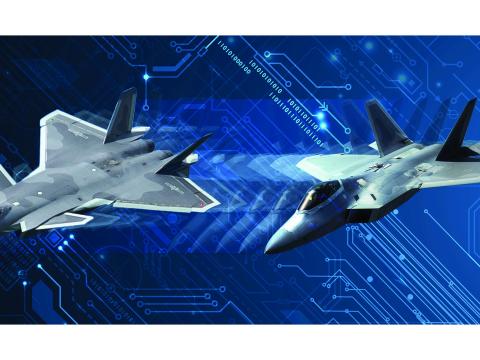Air Force Pushes for More IT Modernization
The U.S. Air Force is moving aggressively to modernize its information technology capabilities to ease its move to the Defense Department’s Joint Information Environment (JIE). The JIE will enable a shared information technology architecture, services and infrastructure across the entire military. But to reach its goals, the service will need to close excess data centers and improve its security policies, explained Lt. Gen. Michael J. Basla, USAF, the Air Force’s chief information dominance and chief information officer (CIO), who spoke at AFCEA NOVA’s 12th Annual Air Force IT Day on December 11.
The Air Force Space Command is currently working on the service’s JIE implementation plan that will be submitted to Teri Takai, Defense Department CIO, in January, Gen. Basla said. Among other things, the plan will define upcoming Air Force modernization efforts such as AFNet, which will operate in a joint environment. The plan also lays out a transition strategy for each of the Air Force’s capability areas: data centers, enterprise services, security architecture, network normalization, identity management and command and control capabilities. “Change will be immediate and visible in some areas, such as the migration to SIPRNet Defense email and the adoption of enterprise unified capabilities,” he explained.
Other changes, such as the migration of systems to core JIE data centers, will take longer, Gen. Basla said. After the migration, some systems such as AFNet will continue to be maintained by the Air Force. While the service will maintain some capabilities, they will operate in a joint environment. “Our expertise in cyber operations and the lessons learned from the AFNet are influencing the JIE,” he explained.
The Air Force has four goals for getting its part of the JIE off the ground: improving mission effectiveness, strengthening enterprise governance, providing effective information technology security and automating information technology capabilities such as creating self-healing networks. There also is a need to tap into the other services' capabilities to help stand up the JIE, Gen. Basla said. To meet its JIE goals, the Air Force is aligning its information technology policies to meet the Defense Department CIO’s goals, he added.
As a part of its information technology modernization process, the Air Force is cutting its infrastructure costs by consolidating its data centers. But the process has taken longer than planned. “I’m not happy at all; it’s taking too darn long,” Gen. Basla admitted.
To speed things up, Gen. Basla maintained that the service needs to revise how it is approaching the consolidation process. While it reduced the number of data centers, a number of things must be considered, such as identity and lifecycle management, he observed. As a first step, the Air Force is cataloging its data centers and reaching out to industry for expertise and advice, he said.
The Air Force is also in the process of migrating its email to Defense Enterprise Email as a part of its modernization efforts. Gen. Basla noted that the NIPRNet migration at Air Force headquarters is almost complete, which will align the service with the Joint Staff and Pentagon efforts. The Defense Information Systems Agency (DISA) is helping the Air Force in this process. In the next few months, he said that the service will begin migrating its Defense Enterprise Email to the SIPRNet.
Security concerns are another aspect of the service’s modernization efforts. The Air Force has reduced its Internet access points from more than 100 to 16, which is a more efficient way to defend its networks, Gen. Basla said. Cutting down the number of access points got the attention of DISA, and limiting them is now a security cornerstone for the JIE, he added.
The Air Force will also begin deploying next-generation firewalls in early 2015 as part of setting up its JIE compliant installation processing nodes, Gen. Basla said. The firewalls and the processing nodes will be part of a “commoditized infrastructure” that will be used across the service. This infrastructure will create a place for deploying new capabilities. It also will allow commanders to focus on coming up with new capabilities instead of building base and facility infrastructure, he said.
Clearing up the information technology acquisition process is another part of the service’s modernization efforts. The Air Force is improving its standard baseline—a strategic technical document designed to mesh with JIE and DISA policies, Gen. Basla said. The improved baseline, which he referred to as the “2B baseline,” is being developed by Air Force Space Command and will cover the service’s short-, medium- and long-term technology goals.
The 2B baseline is an implementation baseline, specifying the protocols, guidelines and overall state of the Air Force’s cyberdomain, Gen. Basla explained. The baseline will also develop the configuration specifications for hardware and software products the service acquires. The Air Force Space Command is also managing the Air Force operations baseline, which is the “as-is” cyberdomain architecture, he adds. The Air Force has also released a target baseline for Web applications. When these various baselines are complete, they will ensure that various capabilities are “baked in” for the entire information environment as opposed to only being present in parts of it, he said.



